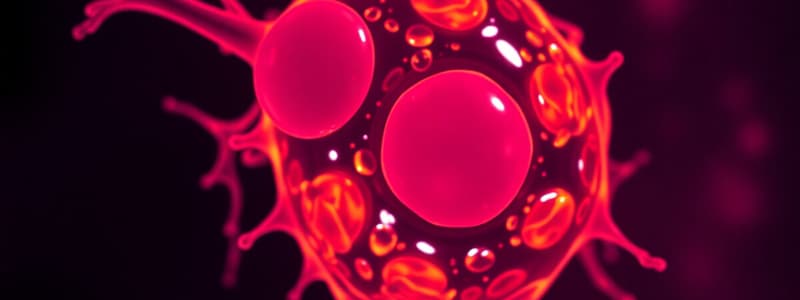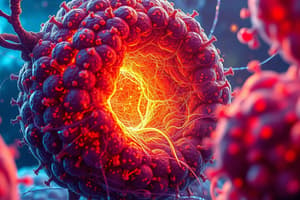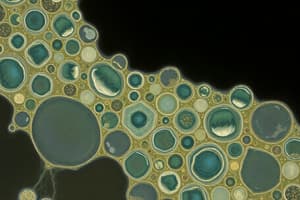Podcast
Questions and Answers
What is the primary function of liver cells?
What is the primary function of liver cells?
- Metabolizing organic compounds (correct)
- Contracting
- Replicating genetic information
- Carrying oxygen
The surface area to volume ratio decreases as cells increase in size.
The surface area to volume ratio decreases as cells increase in size.
True (A)
Who discovered cells and in what year?
Who discovered cells and in what year?
Robert Hooke in 1665
Cells can be specialized; for example, red blood cells are specialized for carrying ______.
Cells can be specialized; for example, red blood cells are specialized for carrying ______.
Match the following stages of human development with their descriptions:
Match the following stages of human development with their descriptions:
Which statement about cell theory is incorrect?
Which statement about cell theory is incorrect?
All cells contain a unique set of genetic information specific to their function.
All cells contain a unique set of genetic information specific to their function.
Approximately how many cells are there in an adult human body?
Approximately how many cells are there in an adult human body?
Which organelle is responsible for synthesizing proteins for export?
Which organelle is responsible for synthesizing proteins for export?
The nucleus is absent in prokaryotic cells.
The nucleus is absent in prokaryotic cells.
What organelle is known as the powerhouse of the cell?
What organelle is known as the powerhouse of the cell?
The __________ synthesizes membrane lipids and detoxifies drugs.
The __________ synthesizes membrane lipids and detoxifies drugs.
Match the following organelles with their main function:
Match the following organelles with their main function:
What are ribosomes primarily composed of?
What are ribosomes primarily composed of?
Which type of movement across membranes requires ATP?
Which type of movement across membranes requires ATP?
Peroxisomes use enzymes to degrade and remove organic complexes.
Peroxisomes use enzymes to degrade and remove organic complexes.
What structure forms spindle fibers during cell division?
What structure forms spindle fibers during cell division?
Facilitated diffusion requires energy in the form of ATP.
Facilitated diffusion requires energy in the form of ATP.
What is osmosis?
What is osmosis?
The primary pump responsible for moving Na+ out of the cell and K+ into the cell is called the ______.
The primary pump responsible for moving Na+ out of the cell and K+ into the cell is called the ______.
Match the following types of movement with their descriptions:
Match the following types of movement with their descriptions:
Which of the following factors does NOT affect the movement of molecules across membranes?
Which of the following factors does NOT affect the movement of molecules across membranes?
Cotransport moves two substances across a membrane in opposite directions.
Cotransport moves two substances across a membrane in opposite directions.
What does tonicity measure?
What does tonicity measure?
Which of the following organelles is primarily responsible for detoxifying drugs?
Which of the following organelles is primarily responsible for detoxifying drugs?
The Golgi Apparatus synthesizes proteins for export.
The Golgi Apparatus synthesizes proteins for export.
What is the function of ribosomes within a cell?
What is the function of ribosomes within a cell?
Mitochondria contain their own ______ DNA.
Mitochondria contain their own ______ DNA.
Match the following organelles with their primary function:
Match the following organelles with their primary function:
What structure in the cytoskeleton is primarily involved in cell movement?
What structure in the cytoskeleton is primarily involved in cell movement?
The nucleus is present in all prokaryotic cells.
The nucleus is present in all prokaryotic cells.
What substance do lysosomes use to degrade and remove organic complexes?
What substance do lysosomes use to degrade and remove organic complexes?
Which of the following statements is true regarding cell theory?
Which of the following statements is true regarding cell theory?
All cell types have the same genetic material but perform different functions.
All cell types have the same genetic material but perform different functions.
What is the significance of the surface area to volume ratio in cells?
What is the significance of the surface area to volume ratio in cells?
The zygote undergoes several stages including the morula and __________.
The zygote undergoes several stages including the morula and __________.
Match the following cell types with their primary functions:
Match the following cell types with their primary functions:
Which of the following organelles is selectively permeable?
Which of the following organelles is selectively permeable?
All cells originate from pre-existing cells, as stated in cell theory.
All cells originate from pre-existing cells, as stated in cell theory.
Who is recognized for discovering cells in 1665?
Who is recognized for discovering cells in 1665?
What is the term for the spontaneous net movement of water through a selectively permeable membrane?
What is the term for the spontaneous net movement of water through a selectively permeable membrane?
Active movement across membranes does not require ATP.
Active movement across membranes does not require ATP.
What does tonicity measure?
What does tonicity measure?
______ is defined as the in-pocketing of the membrane and the formation of a vesicle.
______ is defined as the in-pocketing of the membrane and the formation of a vesicle.
Match the different types of movement across membranes with their descriptions:
Match the different types of movement across membranes with their descriptions:
Which type of membrane pump transports two substances in the same direction?
Which type of membrane pump transports two substances in the same direction?
Facilitated diffusion requires energy in the form of ATP.
Facilitated diffusion requires energy in the form of ATP.
What primary factor does NOT affect the movement of molecules across membranes?
What primary factor does NOT affect the movement of molecules across membranes?
Flashcards are hidden until you start studying
Study Notes
Cells
- Fundamental units of life, capable of specialization into various types such as liver cells, muscle cells, and red blood cells.
- The function of a cell is dictated by the active genes; specialization results in distinct functions, e.g., liver cells metabolize drugs, RBCs transport oxygen, muscle cells enable contraction.
- Despite functional differences, diverse cell types share more similarities than differences.
Historical Perspective
- Robert Hooke identified cells in 1665 with the advent of the microscope, laying the groundwork for cellular biology.
Cell Theory
- Established in the 1830s, consisting of several key tenets:
- Cells are the fundamental structural and physiological units of all organisms.
- Cells can exist as unicellular organisms or as components of multicellular entities.
- All cells arise from pre-existing cells.
- Chemically, cells are comparable.
- Most life’s chemical reactions occur within cells.
- Cells possess genetic information that is replicated and inherited.
Human Biology
- An adult human contains roughly 37.2 trillion cells.
- Development begins from a single zygote, progressing through morula, blastula, and gastrula stages.
Surface Area to Volume Ratio
- Cells maintain a small size to maximize their surface area relative to volume.
- Increasing volume enhances cellular activity but also waste production.
- The inability to expel waste effectively at larger volumes poses a risk to cell survival; notable exceptions include egg cells, skeletal muscle cells, and neurons.
Organelles
- Cell Membrane: A selectively permeable structure composed of a phospholipid bilayer, cholesterol, and membrane proteins.
- Nucleus: Contains DNA, surrounded by a nuclear envelope formed by a double phospholipid bilayer; absent in prokaryotic cells.
- Nucleolus: A dense structure within the nucleus, housing unused DNA.
- Ribosomes: Sites of protein synthesis; some are free (local proteins) while others are attached to rough endoplasmic reticulum.
- Rough Endoplasmic Reticulum (RER): Synthesis of proteins intended for secretion, marked by ribosomes on its membrane.
- Smooth Endoplasmic Reticulum (SER): Lacks ribosomes, involved in calcium storage, lipid synthesis, drug detoxification, and protein modification.
- Golgi Apparatus: Modifies and packages proteins typically for export; characterized by cis (nucleus-facing) and trans (opposite) sides.
- Mitochondria: Powerhouses of the cell responsible for ATP production via cellular respiration, containing their own DNA.
- Lysosomes: Organelles that degrade organic materials using enzymes.
- Peroxisomes: Remove organic complexes using peroxide.
- Cytoskeleton: Provides structure and support; includes microtubules (cilia and flagella for movement) and microfilaments (structural support and intracellular transport).
- Centrioles: Form spindle fibers for cell division, usually existing in pairs termed centrosomes.
Movement across Membranes
- Selective permeability: Regulates movement in and out of the cell.
- Passive Movement: Occurs without ATP, driven by concentration gradients; includes:
- Osmosis: Movement of water from low to high solute concentrations.
- Diffusion: Movement of solutes from high to low concentration.
- Facilitated Diffusion: Utilizes protein channels for specific materials.
- Active Movement: Requires ATP to transport substances against concentration gradients; includes membrane pumps:
- Uniport: Moves one substance in one direction.
- Cotransport: Moves two substances together in the same direction.
- Exchange pump: Moves two substances in opposite directions, e.g., Na+/K+ ATPase.
Factors Affecting Molecule Movement
- Movement depends on molecule size, temperature, charge, and system gradient.
Large Movement across Membranes
- Endocytosis: Membrane in-pocketing to form vesicles; includes:
- Phagocytosis: Ingestion of solid particles or even entire cells.
- Pinocytosis: Ingestion of liquids.
Cells
- Fundamental units of life, capable of specialization into various types such as liver cells, muscle cells, and red blood cells.
- The function of a cell is dictated by the active genes; specialization results in distinct functions, e.g., liver cells metabolize drugs, RBCs transport oxygen, muscle cells enable contraction.
- Despite functional differences, diverse cell types share more similarities than differences.
Historical Perspective
- Robert Hooke identified cells in 1665 with the advent of the microscope, laying the groundwork for cellular biology.
Cell Theory
- Established in the 1830s, consisting of several key tenets:
- Cells are the fundamental structural and physiological units of all organisms.
- Cells can exist as unicellular organisms or as components of multicellular entities.
- All cells arise from pre-existing cells.
- Chemically, cells are comparable.
- Most life’s chemical reactions occur within cells.
- Cells possess genetic information that is replicated and inherited.
Human Biology
- An adult human contains roughly 37.2 trillion cells.
- Development begins from a single zygote, progressing through morula, blastula, and gastrula stages.
Surface Area to Volume Ratio
- Cells maintain a small size to maximize their surface area relative to volume.
- Increasing volume enhances cellular activity but also waste production.
- The inability to expel waste effectively at larger volumes poses a risk to cell survival; notable exceptions include egg cells, skeletal muscle cells, and neurons.
Organelles
- Cell Membrane: A selectively permeable structure composed of a phospholipid bilayer, cholesterol, and membrane proteins.
- Nucleus: Contains DNA, surrounded by a nuclear envelope formed by a double phospholipid bilayer; absent in prokaryotic cells.
- Nucleolus: A dense structure within the nucleus, housing unused DNA.
- Ribosomes: Sites of protein synthesis; some are free (local proteins) while others are attached to rough endoplasmic reticulum.
- Rough Endoplasmic Reticulum (RER): Synthesis of proteins intended for secretion, marked by ribosomes on its membrane.
- Smooth Endoplasmic Reticulum (SER): Lacks ribosomes, involved in calcium storage, lipid synthesis, drug detoxification, and protein modification.
- Golgi Apparatus: Modifies and packages proteins typically for export; characterized by cis (nucleus-facing) and trans (opposite) sides.
- Mitochondria: Powerhouses of the cell responsible for ATP production via cellular respiration, containing their own DNA.
- Lysosomes: Organelles that degrade organic materials using enzymes.
- Peroxisomes: Remove organic complexes using peroxide.
- Cytoskeleton: Provides structure and support; includes microtubules (cilia and flagella for movement) and microfilaments (structural support and intracellular transport).
- Centrioles: Form spindle fibers for cell division, usually existing in pairs termed centrosomes.
Movement across Membranes
- Selective permeability: Regulates movement in and out of the cell.
- Passive Movement: Occurs without ATP, driven by concentration gradients; includes:
- Osmosis: Movement of water from low to high solute concentrations.
- Diffusion: Movement of solutes from high to low concentration.
- Facilitated Diffusion: Utilizes protein channels for specific materials.
- Active Movement: Requires ATP to transport substances against concentration gradients; includes membrane pumps:
- Uniport: Moves one substance in one direction.
- Cotransport: Moves two substances together in the same direction.
- Exchange pump: Moves two substances in opposite directions, e.g., Na+/K+ ATPase.
Factors Affecting Molecule Movement
- Movement depends on molecule size, temperature, charge, and system gradient.
Large Movement across Membranes
- Endocytosis: Membrane in-pocketing to form vesicles; includes:
- Phagocytosis: Ingestion of solid particles or even entire cells.
- Pinocytosis: Ingestion of liquids.
Studying That Suits You
Use AI to generate personalized quizzes and flashcards to suit your learning preferences.




